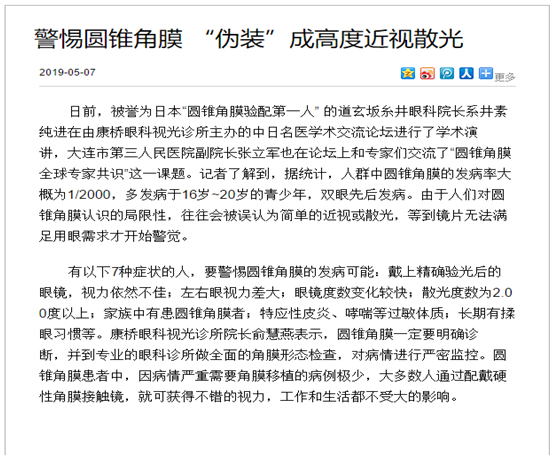2019.05.07
Medical news
Beware: Keratoconus Is Often Mixed Up with High Myopia and Astigmatism
A Japan-China medical exchange forum was held on April 27, hosted by Kangqiao Clinic of Ophthalmology and Optometry. Motozumi Itoi, Director of Dogenzaka Itoi Eye Clinic, who is known as "leading keratoconus corrector" in Japan delivered an academic lecture, and many ophthalmologists and scholars from Japan and China attended the meeting. In the forum, Zhang Lijun, Deputy Director of Research, Third People's Hospital of Dalian, exchanged views with experts on the issue of "global expert consensus on keratoconus."
According to statistics, the prevalence of keratoconus is about 1 in 2000. It occurs primarily in adolescents aged 16 to 20 years and is usually bilateral. Because of insufficient public awareness, keratoconus is mistaken for simple myopia or astigmatism, and it is not until lenses can no longer correct myopia that the patient realizes the presence of the illness. Keratoconus should be suspected if the following seven symptoms apply.
- Inadequate correction even with the use of glasses following detailed eye examination
- Significant difference in visual acuity between the left eye and the right eye
- Rapid progression of myopia
- Astigmatism with a degree of 2.00 or higher
- Family history of keratoconus
- Allergic dermatitis, asthma, and other allergies
- Habit of long-term blinking
According to Yu Huiyan, director of Kangqiao Clinic of Ophthalmology and Optometry, keratoconus is often mistaken for simple myopia or astigmatism because of insufficient public awareness, and the diagnosis of keratoconus should therefore be rendered based on a comprehensive examination by a specialist using specialized equipment. The state-of-the-art anterior segment OCT may be used for confirmation of the diagnosis. Keratoconus should be accurately diagnosed and thoroughly examined for corneal morphology at an ophthalmology clinic with expertise. Its symptoms should also be closely monitored. Keratoplasty is rarely performed in patients with keratoconus because of severe symptoms. In many cases, patients can obtain good vision by wearing hard contact lenses, without substantial impact on their work and life.





